How to Clean Composite Decking: The Complete Guide

Are you having trouble cleaning your composite decking? No matter the color of your deck it is important to know how to clean composite decking properly to maintain your deck’s beauty. Wood composite is specially engineered to last longer than traditional wooden decks; however, you still need to care for your decking properly.
Thankfully, wood composite decking does not need to be sanded or restrained yearly for protection, so maintenance is easier than a wooden deck. A composite wood deck needs to be cleaned periodically. Here are 6 simple steps to learn how to clean composite decking.
6 Steps to Cleaning Composite Decking

Before cleaning your composite deck, check your decking manufacturer’s cleaning requirements. Most manufacturers offer their deck cleaning solution for a deep clean; however, you will only need the following products for a routine composite deck cleaning.
- 5-gallon bucket of warm water
- Standard bottle of dish soap
- Medium stiffness nylon broom or brush
- Leafblower, terry towel, sponge, or mop
We recommend cleaning composite decking twice yearly when the temperature exceeds 55 ℉. The best times are early spring and late fall.
Suppose your home has experienced extreme weather. Instead of waiting until the scheduled cleaning, you should clean it immediately. If any moisture, leaves, dirt, etc., sit on your deck for an extended period, they will leave discolored marks. Cleaning after an extreme storm will prevent moisture damage. Here are the steps to cleaning your composite deck.
Clear Your Deck

The first step in learning how to clean composite decking is prepping your deck for rinsing. Move any deck furniture and plants. Covering plants or yard ornaments near your deck is an excellent way to protect them from cleaning products. Clearing your deck allows you to reach every area when cleaning.
Sweep Decking

Once your deck is clear, sweep with a broom to clear any loose debris. Remove any leaves or branches and check the crevices between the decking. You can remove any packed dirt from the crevices or corners of your deck with a small brush or a pressure washer. Be careful not to damage the composite coating with your pressure washer. Read the pressure washing section of this guide beforehand to prevent damage.
Rinse With Water
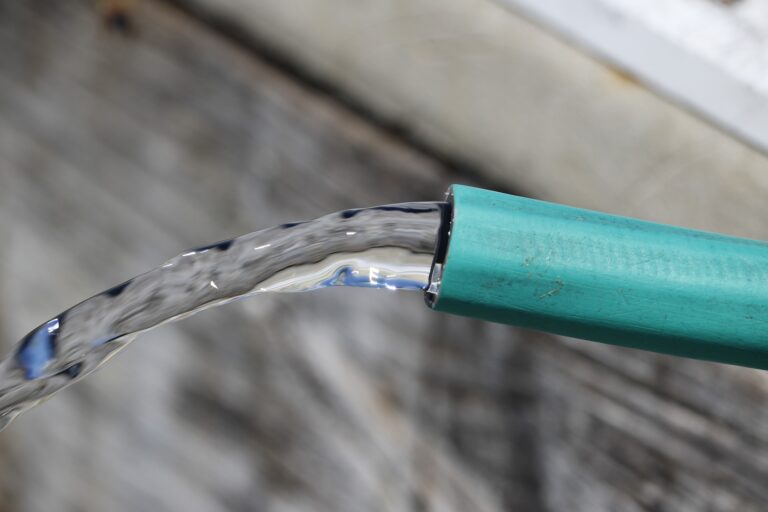
Now that you swept your deck, it is time to rinse your deck to get it ready for soap. You can hose the deck down with a garden hose or dump several buckets of water on the deck. A garden hose is very helpful when cleaning debris between your deck boards.
Apply Soap
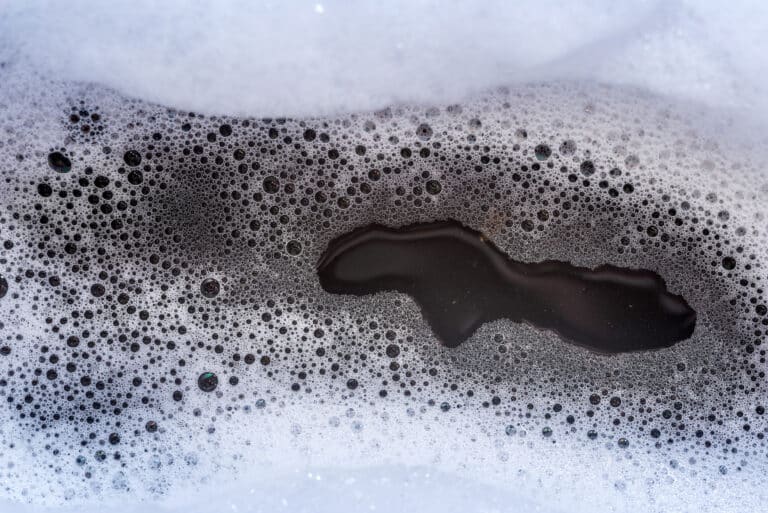
Mix a solution of warm water and dish soap. Mix to about the same concentration you would use to wash dishes. A five-gallon bucket is perfect for mixing the soap and water. This can be an effective composite deck cleaner.
Scrub Down

Now it is time to use your brush or medium-stiffness broom. Dunk the brush in the bucket and start scrubbing! Use extra pressure when scrubbing between deck boards to remove dirt. Scrub the whole deck and clean out the grooves.
Final Rinse

Once you are done scrubbing down the deck, it is time to rinse off the deck. Rinse away the soap and dirt using a garden hose or buckets of water. Let your deck air dry, or use a leaf blower or towels. Ensure your deck is dry before replacing the furniture and other decorative items.
Advanced Composite Decking Cleaning
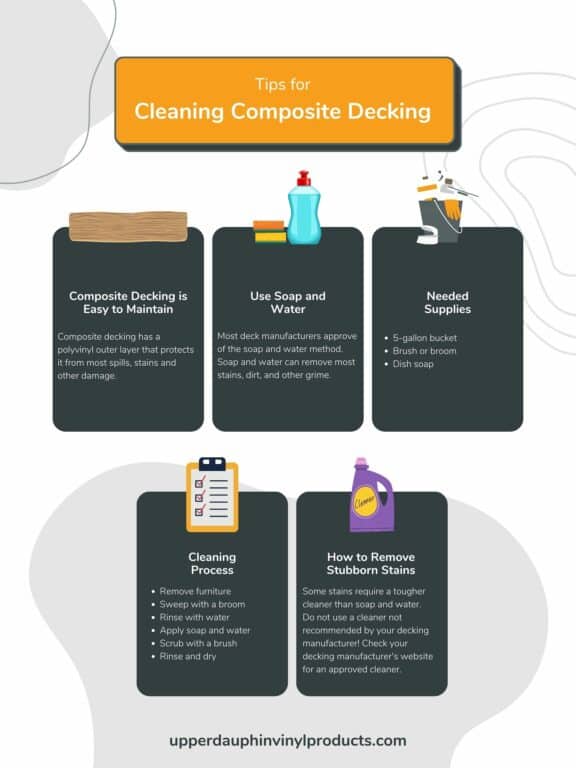
Eventually, you will encounter a few common stains and problems with composite decking. These stains include mildew, debris, packed dirt, food, grease, pollen, and hard water. Don’t worry! These issues and stains plague wooden decks but are easy to remove from composite decking. Here is how to clean composite decking to remove each problem.
Mildew/Mold
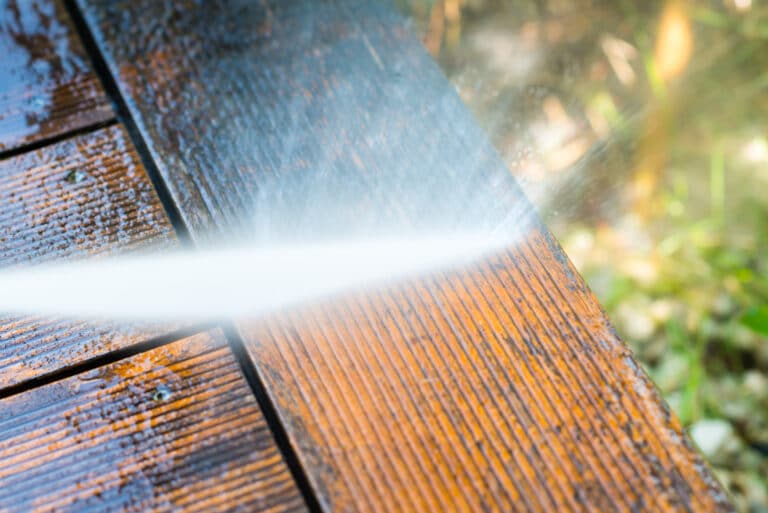
Mildew or mold will damage a standard wooden deck; however, it will not damage composite decking. Composite wood boards have a protective layer of PVC, which mold and mildew can’t penetrate. The PVC coating is smooth, so cleaning composite decking with mold spots shouldn’t have an issue. You can easily remove mold and mildew by following the standard soap and water method mentioned in this guide.
Debris

In rural areas, leaves, pollen, and twigs will land on your deck. The best way to avoid spots is to sweep your deck to remove general debris regularly. General tree debris will not damage your deck; however, oils from wet leaves will stain your deck if left unattended.
Also, leaves and twigs can provide excellent growing conditions for mold, which could start growing on your deck. If your deck has spots from leaves or twigs, use the soap and water method and scrub down your deck.
Dirt Between Boards

The small gaps between composite deck boards can be hard to clean. These gaps can trap dirt and grime over time. If you have dirt between your deck boards, start with the soap and water method and scrub between the boards. If that method or a hose doesn’t work, you can use a pressure washer but be careful! Use a fan tip and no more than 1,500 psi when pressure washing composite wood decking.
Food Stains

You may leave a stain if you spill food or beverages on your deck. If you clean up the spill immediately with a paper towel, you will likely not have a stain. Sometimes, a paper towel will not work, but a good clean with soap and water should do the trick. Thankfully, the PVC makes cleaning composite decks a breeze!
Grease Stains
You probably have your outdoor Barbecue on your deck. Occasionally, food grease will drip on the decking from your grill. Thankfully, oil and grease stains are not permanent if you take care of them promptly. You can easily spot-clean the area with soap and water to remove the stain. Trex requires all food stains to be removed within 7 days, so prompt cleaning is necessary!
Pollen

Do trees surround your home? If so, you will get a thin spring pollen covering on your deck. Pollen doesn’t cause long-term damage, but you should remove it. Use a pressure washer but a fan tip, and do not use a washer with more than 1,500 PSI. If you use too much psi, you could damage the outer layer of your deck boards. Any cracks in the outside layer will let water in, rotting the inner wooden layers.
Hard Water Stains

Hard water has high amounts of mineral deposits like lime and silica. The minerals are left behind when hard water dries, leaving ugly spots on your decking. Use white vinegar to remove these spots, and rinse with water. Avoid using hard water to rinse the deck since it will cause new stains. If you don’t have any other option, use hard water to rinse and immediately dry with a blower or towel.
How To Remove Ice and Snow From Composite Decking

If you want to learn how to clean composite decking, it is important to care for your deck in the winter months. You won’t frequent your deck during the winter, but you may want to clear a pathway at some point. However, you can damage your decking if you do not clean off snow correctly. Here are the safest ways to remove snow from your deck.
Can I Use a Shovel to Clean Composite Decking?

You can use a plastic shovel to clear snow but use something other than a metal shovel. Remember, composite decking has a polyvinyl layer on the boards’ outside. You must be careful not to scratch the boards and damage the top layer.
When using a shovel, be very careful and scrape with the grain of your deck boards. Scraping your shovel across the grain increases the chance of damage. Alternatively, if you have light snow, use a broom or a blower to avoid accidentally scratching the decking surface.
Can I Use a Snowblower on Composite Decking?

Using a snow blower on a deck is a bad idea. A snow blower has metal edges that can easily damage your deck. You may be tempted to use your snow blower but remember, large deck repair bills are worse than 10 minutes of shoveling. A snow blower will likely damage your deck, so look for another solution.
Can I Use Rock Salt or Ice Melt?
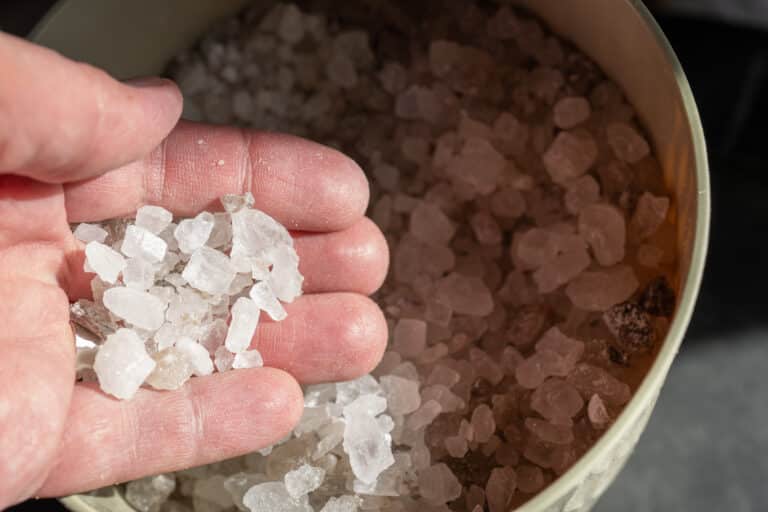
Ice is a fall hazard, so clearing ice from your deck is essential. You can use rock salt or calcium chloride, depending on your manufacturer’s recommendations. Always check your decking manufacturer’s cleaning guidelines before using rock salt or calcium chloride.
We carry Trex decking, a widespread brand of composite decking. You can use rock salt or calcium chloride on the Newer Trex decking series, like Trex Transcend®, Enhance®, and Select®. You can also use rock salt or calcium chloride if you have older Trex decking like the Accent series. However, you need to clean it off as soon as possible to prevent damage.
Can I Power Wash Composite Decking?

Using a power washer may be very helpful when learning how to clean composite decking, but there are a few essential tips to follow when using a power washer. Remember, a pressure washer will blast caked dirt off your deck, but you should also use soap if you want a complete deck cleaning. Here are a few pressure-washing guidelines.
Use Fan Tip With Distance
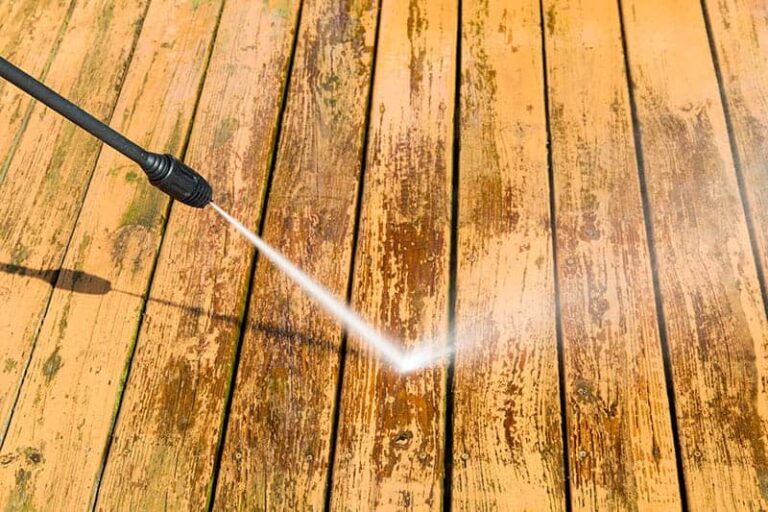
You will carve into your composite decking if you use too strong of a nozzle. To prevent damage, use a fan tip and stay 6″ away from the decking. Use a fan tip, not a turbo nozzle or a 0-degree nozzle.
Don’t Exceed 1,500 PSI
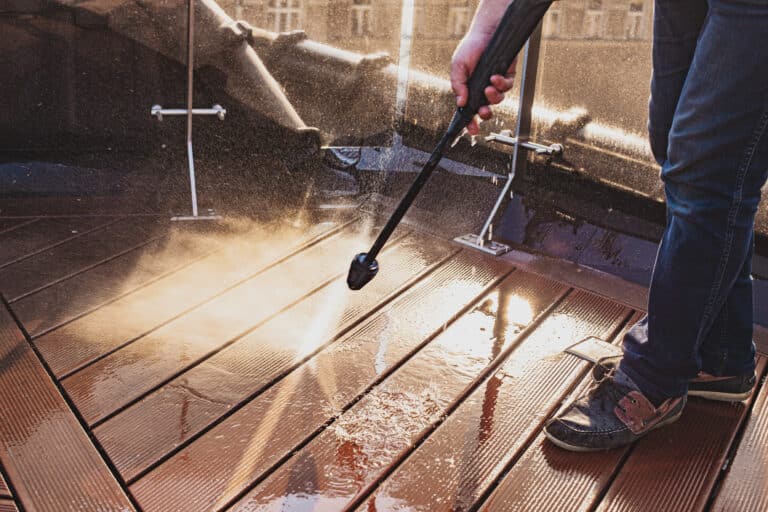
Never use more than 1,500 PSI when power washing composite decking. Some manufacturers allow more than 1,500 PSI but always check with them before pressure washing. Any pressure above 1,500 PSI can damage the surface of your decking. If the outside layer is breached, water can reach the wooden core of the board and start rotting.
Wash With The Grain

Clean with the grain of the boards when pressure washing. Washing with the grain prevents marking the boards. Going against the grain or crossing several boards can score them if you are not careful.
Cleaning Solutions to Avoid on Composite Decking

You may have wanted to try a chemical cleaner on your deck for tough stains. Do not use chemical cleaners on composite decking! Composite materials are designed to be easier to clean so that most stains can be removed with soap and water. Here are a few cleaners to avoid.
Don’t Use Bleach
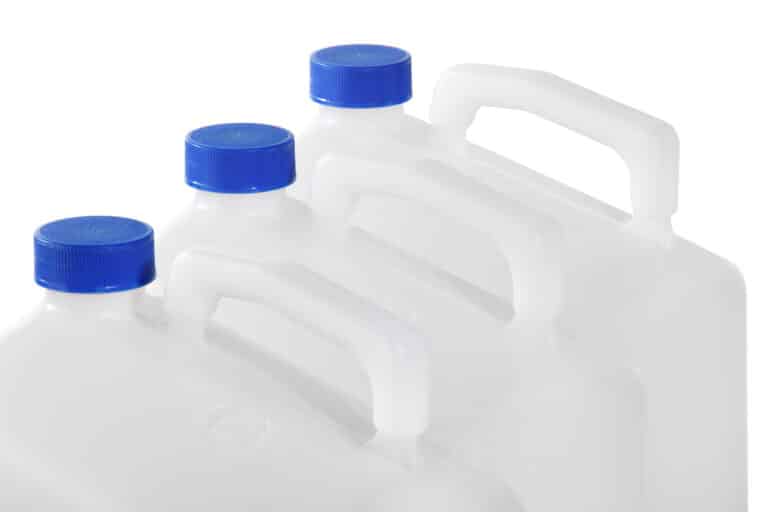
Bleach is not a good composite deck cleaner and will eat away at the composite material and will leave permanent stains. Bleach permanently whitens the area you apply to on your deck, leaving a nasty white spot. Decking manufacturers sell deck cleaners that will achieve what you need without the damage caused by bleach.
Don’t Use Acetone
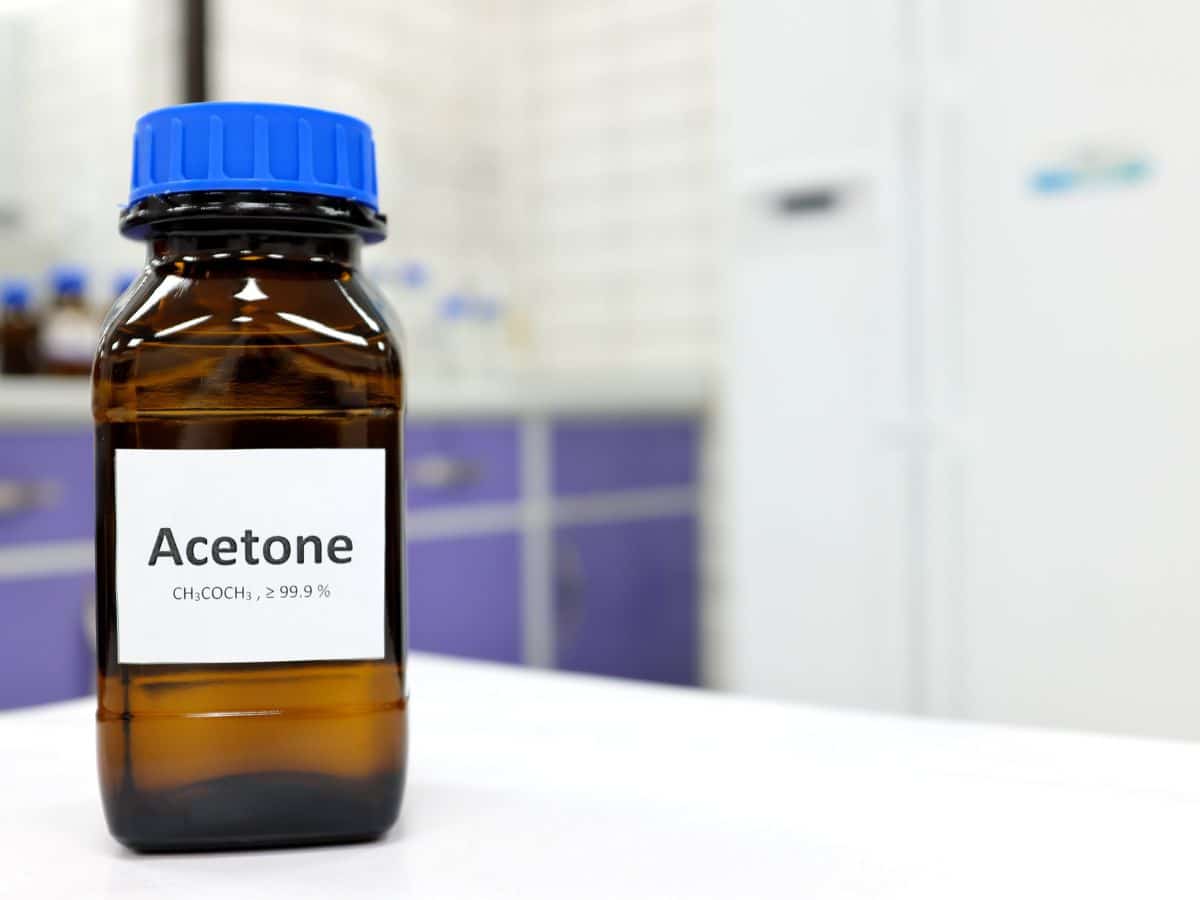
Acetone is not a good method if you are wanting to learn how to clean composite decking, and other solvent chemicals can damage the outer composite layer and stain your decking. Never use acetone to clean composite decking. Use a manufacturer-recommended deck cleaner instead.
How To Keep Composite Decking Looking New

Composite decking requires less maintenance than wooden decking and is more resistant to staining and fading. While composite is more durable than wood, there are a few tips you can use to keep your decking looking like it is new.
Sweep Regularly

Sweeping helps keep your deck looking new. Consistently sweeping your deck will help keep your deck in tip-top shape, especially after storms. Leaves and other debris contain oils that can slightly stain your deck or cause tannins. You can easily remove these stains. However, it is easier to sweep soon after the storm instead of waiting until you need to complete a full cleaning.
Spot Clean
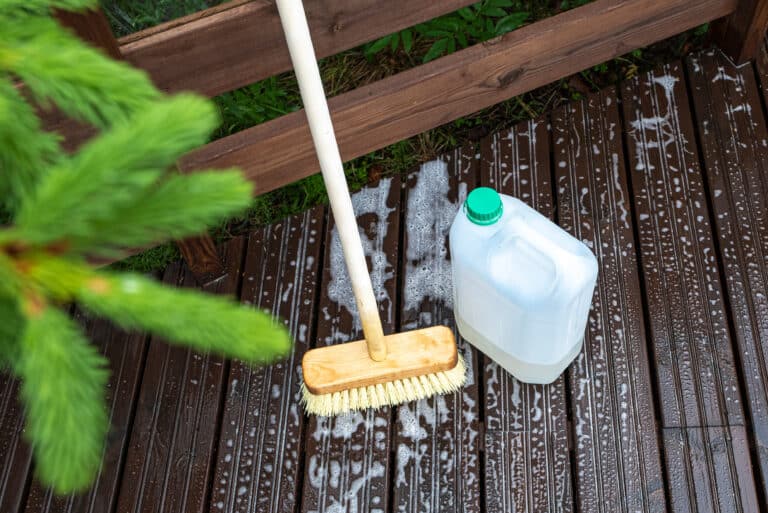
Spot-cleaning composite decking will be easier than waiting and cleaning later. You don’t need to clean your entire deck to remove a food spill. If you have a food or grease spill, you can wash the small area of your deck instead of waiting until your scheduled cleaning. Don’t wait for months to clean since the stains will be harder to remove.
Clean Spills
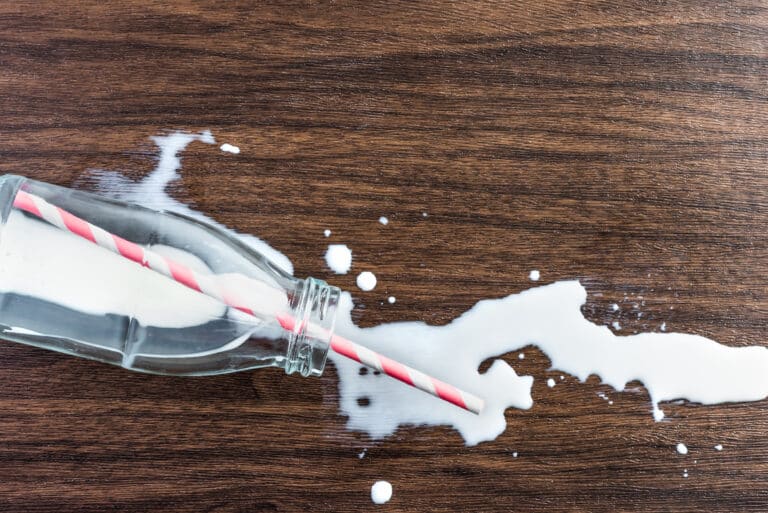
Most food and drink spills can be wiped up right away with a paper towel avoiding stains. Immediately cleaning up a spill will be more effective than spot-cleaning the stain later. Cleaning up spills on composite decking is a breeze due to the PVC cap on the boards.
Remove Mold ASAP
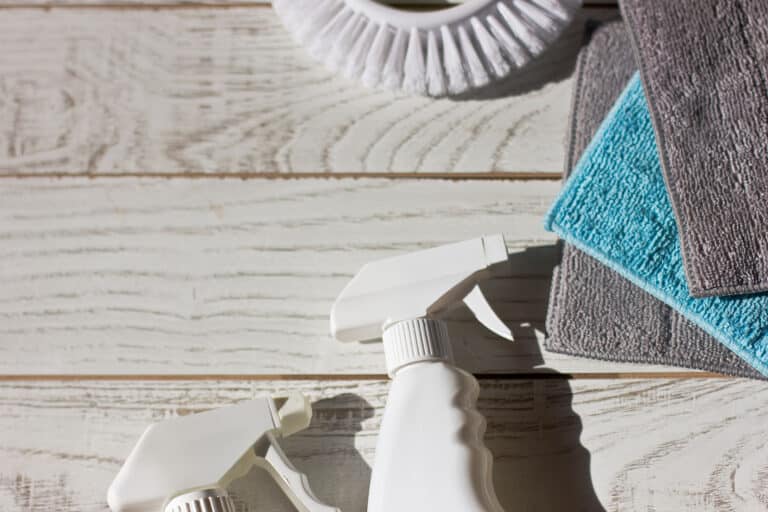
Mold will not damage composite decking due to the PVC capping. However, mold is ugly and will grow, tarnishing your beautiful outdoor living space. Give your deck a good scrubbing to remove the mold and its food source to prevent the mold from growing.
Remove Tannin Stains

Tannin is the collective name for the acidic chemicals in liquid sap, leaves, and other plant matter. If leaves or branches sit on your deck too long, the tannin oils will wash out of the plant matter and cause temporary blueish-black stains on the decking. You can easily remove these stains using a special “deck brightening” cleaner containing oxalic acid. Your decking manufacturer will have cleaning instructions or their own branded deck brightener. Always check the manufacturer’s recommendations before using a deck brightening solution.
Tip: Deck brightening cleaners will temporarily lighten the color of your decking, so we recommend applying the cleaner to the whole deck to avoid uneven coloring.
Check Dryer Vents

Dyer vents release warm moist air. If your dryer vent blows towards your deck, it can create a mold and mildew breeding ground. Turn your vent in the other direction if you struggle with mold in the vent area.
Conclusion
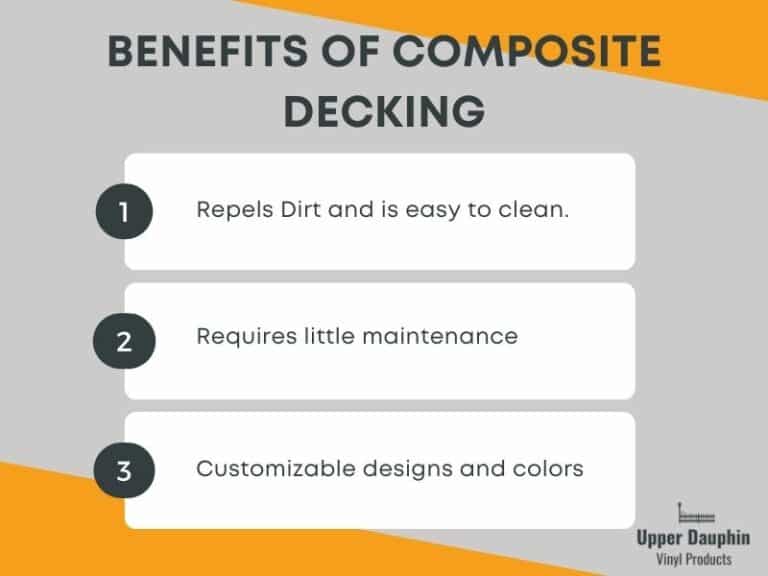
Composite decking is easier to clean than traditional wooden decks; however, it is essential to clean your deck regularly. We recommend cleaning your deck at least twice a year, but you should clean it more often if it is dirty. The standard process to clean composite decking is as follows.
- Clear your deck of objects
- Sweep your deck
- Rinse with water
- Apply dish soap
- Scrub with a brush
- Rinse with water
We are a local deck builder in south-central Pennsylvania. If you want a free consultation for a deck builder in the area, fill out our free quote form or contact us. We would love to turn your outdoor living dreams into reality! Check out our completed projects if you are interested in a new deck. Here, you can find inspiration for your composite deck.
